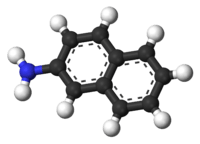2-Naphthylamine
| | |
 | |
| Names | |
|---|---|
| Preferred IUPAC name
Naphthalen-2-amine | |
| Other names
(Naphthalen-2-yl)amine 2-Naphthylamine β-Naphthylamine | |
| Identifiers | |
| 91-59-8 | |
| 3D model (Jmol) | Interactive image |
| ChEBI | CHEBI:27878 |
| ChEMBL | ChEMBL278164 |
| ChemSpider | 6790 |
| ECHA InfoCard | 100.001.892 |
| KEGG | C02227 |
| |
| |
| Properties | |
| C10H9N | |
| Molar mass | 143.19 g·mol−1 |
| Appearance | White to red crystals[1] |
| Odor | odorless[1] |
| Density | 1.061 g/cm3 |
| Melting point | 111 to 113 °C (232 to 235 °F; 384 to 386 K) |
| Boiling point | 306 °C (583 °F; 579 K) |
| miscible in hot water[1] | |
| Vapor pressure | 1 mmHg (107° C)[1] |
| Acidity (pKa) | 3.92 |
| Hazards | |
| Flash point | 157 °C; 315 °F; 430 K |
| Related compounds | |
| Related compounds |
2-Naphthol |
| Except where otherwise noted, data are given for materials in their standard state (at 25 °C [77 °F], 100 kPa). | |
| | |
| Infobox references | |
2-Naphthylamine is one of two isomeric aminonaphthalenes, compounds with the formula C10H7NH2. It is a colorless solid, but samples take on a reddish color in air because of oxidiation. The aromatic amine used to be used to make azo dyes. It is a known carcinogen and has largely been replaced by less toxic compounds.[2]
Preparation
2-Naphthylamine is prepared by heating 2-naphthol with ammonium zinc chloride to 200-210 °C, the Bucherer reaction. It also can be produced its acetyl derivative by heating 2-naphthol with ammonium acetate to 270-280 °C.
Reactions
It gives no color with iron(III) chloride. When reduced by sodium in boiling amyl alcohol solution, it forms tetrahydro-3-naphthylamine, which exhibits the properties of the aliphatic amines in that it is strongly alkaline in reaction, has an ammoniacal odor and cannot be diazotized.
On oxidation, it yields ortho-carboxy-hydrocinnamic acid, HO2CC6H4CH2CH2CO2H.
Numerous sulfonic acid derivatives of 2-naphthylamine are used in commerce, such as precursors to dyes.[2] Owing to the carcinogenicity of the amine, these derivatives are mainly prepared by amination of the corresponding naphthols. Of them, the δ-acid and Bronner's acid are of more value technically, since they combine with ortho-tetrazoditolyl to produce fine red dye-stuffs.
Role in disease
2-Naphthylamine is found in cigarette smoke and suspected to contribute to the development of bladder cancer.[3]
It is activated in the liver but quickly deactivated by conjugation to glucuronic acid. In the bladder, glucuronidase re-activates it by deconjugation, which leads to the development of bladder cancer.
See also
References
- 1 2 3 4
- 1 2 Gerald Booth "Naphthalene Derivatives" in Ullmann's Encyclopedia of Industrial Chemistry, 2005, Wiley-VCH, Weinheim. doi:10.1002/14356007.a17_009.
- ↑ CDC - NIOSH Pocket Guide to Chemical Hazards